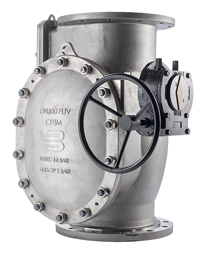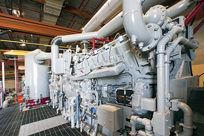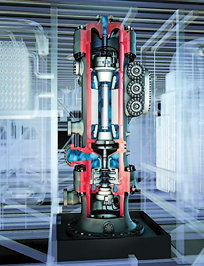Gas processing news
Bob Andrew, Technical Editor
Cryogenic valves for new vessels

Parker Bestobell Marine received a major new order from Daewoo Shipbuilding and Marine Engineering (DSME) in South Korea to supply cryogenic valves for three new vessels. The company’s valves will be used in the cargo-handling systems, including the main discharge line that controls the initial flow of LNG from the cargo tanks when pumping starts.
The three vessels are part of the Yamal series of Arc7 ice-class LNG carriers that will be operated in Arctic winter conditions. Parker Bestobell Marine previously supplied cryogenic globe and check valves to the first vessel in the series, owned by Russia’s Sovcomflot.
The “on-deck” valves will be subjected to extreme sub-zero temperatures, which is not an issue with cryogenic valves designed to operate at a temperature as low as –196°C. For added protection, Parker Bestobell Marine will supply covers for the headworks to protect exposed valve parts.
Due to the arctic conditions in which the LNG carriers will operate, it is not possible to use actuators, which operate via hydraulic oil due to viscosity issues. As a result, Parker Bestobell Marine innovated within its valve design to ensure that the valves could operate efficiently using electric actuators. The LNG carriers will be the first to have electric actuators fitted to globe valves.
Fifteen ships are planned to be built in this series by DSME for three different owners: Mitsui O.S.K Lines (Japan), Teekay (Canada) and Dynagas (Greece). The ships are designed specifically for the LNG Yamal project in Russian Siberia. The 15 Arc7 ice-class gas carriers will operate in Arctic conditions, with temperatures as low as –54°C. They will be required to independently navigate ice more than 2 m thick.
GTL conversion without CO2 emissions
A team of scientists from CoorsTek Membrane Sciences, the University of Oslo in Norway, and the Instituto de Tecnología Química in Spain has developed a new process to use natural gas as a raw material for aromatic chemicals. The process uses a ceramic membrane to make the direct, non-oxidative conversion of gas to liquids possible for the first time. This process reduces cost, eliminates multiple process steps and avoids carbon dioxide (CO2) emissions. The resulting aromatic precursors are source chemicals for jet fuel, insulation materials, plastics and textiles, among other products.
Direct activation of methane has been a key goal of the hydrocarbon research community for decades. By using a ceramic membrane that simultaneously removes hydrogen and injects oxygen, the team was able to produce liquid hydrocarbons directly from methane in a one-step process.
Temperature and pressure have historically been the main parameters chemists and engineers have used to control reactions. Catalysts can improve speed and selectivity without promoting reactions beyond their chemical equilibrium limit. Integrating a ceramic ion-conducting membrane into the reactor enables an increase in productivity of industrially appealing processes that are otherwise impractical due to strong thermodynamic constraints. The ceramic membranes are made from abundant materials like barium and zirconium, found within large sand deposits, with the addition of thin electrocatalytic layers of plentiful metals like nickel and copper.
While the reactor costs will be standard, the results enabled by this new process have the potential to improve both the financial and environmental costs of chemical production.
Compressor repair savings with unique chemistry

A midstream gas plant in Texas was experiencing severe black powder fouling resulting in compressor, valve and piston failures on two compressors each week. The plant looked to U.S. Water’s energy team for a system solution.
After a plant survey, the team discovered that the formation of black powder was the cause of unscheduled compressor downtime.
The first recommendation was to conduct a trial antifoulant chemistry on the second-stage compressor inlet to remove the blockage and measure the debris concentration located in the gas streams. The results from the debris analysis allowed U.S.
Water to formulate a custom inhibitor package for the two separate trains. Working together with the engineering and equipment team, chemical feed equipment was designed to allow the plant to deliver the antifoulant by atomization throughout the entire system.
Since the plant introduced U.S. Water’s solution into its system, one compressor has been running uninterrupted, and the other has been on a six-month run. In addition to continuous production, the plant was able to save $670,800.
Automation and safety systems for Goldboro LNG

Honeywell Process Solutions will provide full automation and safety systems and serve as the integrated main automation contractor (I-MAC) for a new LNG facility being built in Eastern Canada to process North American natural gas for international export.
Located on the eastern shore of Canada in Nova Scotia, Pieridae Energy’s Goldboro LNG project will include a natural gas liquefaction terminal and facilities for LNG storage and marine export. The facility will be able to process 10 metric MMtpy of LNG and have a storage capacity of 690 Mm3. Startup is expected in 2021.
Honeywell is responsible for designing, delivering and installing the distributed control systems, safety instrumented systems, fire and gas systems and operator training simulator for the project. The company will also be responsible for helping Pieridae integrate all plant infrastructure to the business enterprise systems.
Specific key deliverables include a number of Honeywell’s patented technologies. By leveraging these integrated solutions, Honeywell will reduce risks and minimize potential schedule delays for both Goldboro LNG and its engineering, procurement and construction contractor during the facility startup.
Regasification system for ship conversion

Wärtsilä has been contracted to supply the regasification system for an FSRU conversion project that Höegh LNG plans to carry out on a modern LNG vessel.
The Wärtsilä regasification system to be supplied will feature regasification technology using water glycol as the intermediate medium, instead of propane. This provides a more compact solution, as it is approximately 15% smaller and lighter than the propane-based system.
The Wärtsilä scope of supply for this project comprises the water glycol regasification module, the water glycol/seawater heaters and the pumps. Delivery is scheduled for autumn 2017. Wärtsilä previously supplied eight regasification systems to Höegh LNG.
Subsea compression for Ormen Lange pilot

Following an extensive, multi-year test program of Shell’s Ormen Lange pilot system, GE Oil & Gas announced that A/S Norske Shell has successfully completed system testing of the world’s first subsea gas compression system with a full subsea power supply, transmission and distribution system. The system further advances the development of hydrocarbon processing on the seabed.
The Ormen Lange pilot system was a first of its kind, designed to test a full-scale integrated subsea compression system in submerged conditions with real hydrocarbons. It has been operated by A/S Norske Shell and license partners Petoro, Statoil, Dong and ExxonMobil since 2011 at Shell’s test facility at Nyhamna in Norway, where gas from the Ormen Lange field reaches shore.
GE Oil & Gas has collaborated with Shell on the development of the compression system and supplied a number of its technologies, including the Blue-CTM compressor—a centrifugal compressor specifically designed for subsea—and the world’s first subsea power supply, transmission and distribution system. The system enables operators to conduct gas compression on the seabed, reducing the need to introduce additional power generation on nearby offshore facilities.
At the heart of the compressor is the electrical package provided by GE’s Power Conversion business. The high-speed motor and the high power drive provided are capable of operating hundreds of meters below the sea level reliably. GE technologies tested as part of the Ormen Lange Pilot include a 12.5-MW, fully marinized, vertically oriented centrifugal compressor; the subsea power supply, transmission and distribution system featuring switchgear, variable speed drives, uninterruptible power supply and a dry-mate connector; electric actuators; and an acoustic leak detection system.




Comments